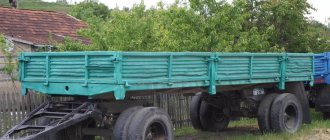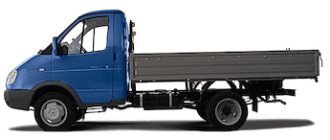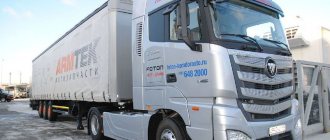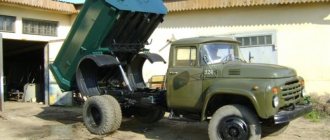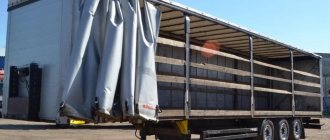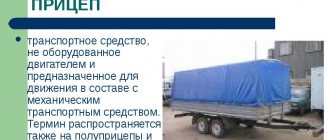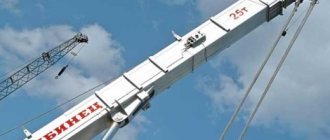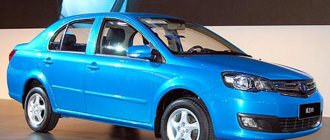The vehicle's carrying capacity is the difference between its gross weight (with contents and people) and its unladen weight. It is calculated by subtracting the second indicator from the first, both numbers are indicated in the PTS by the vehicle manufacturer. A passenger car can transport a maximum of 2.5 tons, a truck - over 8 tons, and a road train - up to 28 tons.
Sometimes the carrying capacity indicated in the PTS does not correspond to the real one; it can be more or less than this value. Then it’s worth making a change to the document by contacting the traffic police and identifying the real indicator with the help of an examination. Otherwise, the driver will receive a fine of 500 rubles for overloading.
In this article:
What is the vehicle's carrying capacity?
The carrying capacity of a vehicle is the weight of the contents it is designed to transport, that is, one of the main characteristics for operation. This includes the weight of the driver and other people in the car; for each unit it is taken as 75 kg. Tonnage matters for any car, even a passenger car, because this type of transport often carries not only passengers, but also their luggage and other property.
The rated load capacity is not stated in the car's passport, but is calculated based on the technical data from the document. For a passenger car this is 0.5-2.5 tons, for a truck – up to 28 tons. And it does not always correspond to the actual value of the indicator. After all, the quality of the road also matters here.
Saddle Maintenance
The condition of the “fifth wheel” is monitored at least 2-3 times a month. Frequent inspection will prolong the performance of the SSU. Therefore they recommend:
Should it be regulated?
Adjusting the saddle on a tractor is one of the conditions for maintaining the functionality of the mechanism. During transportation, the saddle wears out quickly. It is impossible to determine the correct operation of the stove visually, so you need to know some of the reasons and a list of common breakdowns of truck components. A characteristic sign for adjustment is the appearance of a knocking sound when the road train stops and moves.
Note:
The adjustment is quick: you need to remove the saddle and, if necessary, change the rubber bands and bushings; Rinse thoroughly and clean the wedge area from dirt and dried oil.
Eliminating Gaps
The vertical power supports of the tractor are not always subject to deflection under the influence of high load pressure on the frame. During turns, a lot of pressure is applied to the saddle in a perpendicular direction, which greatly injures the upper part of the plate, on the surface of which small gaps form. During operation, the coupling pin wears out quickly. This part requires separate repairs from specialists.
York and Jost seat clearances are eliminated by pressing the locking wedges against the king pin. Manipulations to remove gaps are carried out using a screw control or an automatic metal spring.
Important Terms
To understand the term “carrying capacity”, several more concepts related to it are important:
. This is the weight of the car without additional elements (gasoline and other liquids, spare parts, tools necessary for the operation of the equipment), driver, passengers, cargo.
Dry weight- Curb weight (in PTS it is designated as “weight without load”). This is the weight of the vehicle with all the components that ensure its performance.
This includes fuel, antifreeze, other liquid components, spare parts, and tools necessary to maintain functionality. In some European countries, the curb weight also includes the weight of the driver, because without it the car cannot be driven.
- Gross weight (in the PTS it is written “permitted maximum weight”). This is the weight of the car when it is refueled, there is a driver, passengers, cargo, and luggage in it. To calculate the indicator, the manufacturer uses the maximum permissible pressure on the axle.
SSU device
The load-bearing plate in the SSU has a simple structure and takes on part of the weight of the load. The part has a slot for the entrance of the semi-trailer kingpin to establish a strong fixation. The joint mechanism with the tractor when turning will be the axis of the truck's bend. At the bottom of the slab there is a coupling-fixing system. Automatic connection of parts plays the role of a reliable lock. There are two types of SSU - pivot and pivotless (roller).
Nominal and maximum vehicle load capacity
The maximum load capacity of a vehicle is the largest mass of contents that it can transport without harm to its own technical condition, controllability, and maneuverability. The indicator characteristic of different categories of machines has different values:
More on AutoLex.Net:
8 best cars for passenger comfort
| Truck | 24-28 t, depending on the number of axles |
| A car | 0.5 to 2.5 t |
| Truck | from 0.5 to more than 8 t |
The rated maximum load capacity is calculated based on data from the vehicle title, that is, it is actually determined by the vehicle manufacturer. But the real value of this indicator also depends on the quality of the road. On a good road surface, a car can sometimes carry much more than what is indicated in the documents. A bad road will not allow the vehicle to move even the weight that the manufacturer established in sections 14 and 15 of the PTS.
Semi-trailers
Semi-trailers from the Minsk Automobile Plant.
The model range of MAZ semi-trailers is so huge that a separate book needs to be published for this, so we will briefly touch on this topic.
Below is the main model range of semi-trailers from the branch of Minsk Automobile.
Loading capacity of semi-trailers is from 15 to 33 tons.
The scope of application of MAZ semi-trailers is huge, from long-distance transportation of cargo with food (refrigerated semi-trailers) to transportation of various containers (container ships).
MAZ-931010-3010.
MAZ-975800-041.
MAZ-953000-010.
How to determine the carrying capacity of a car step by step according to PTS
There are two ways to determine the carrying capacity of a car or truck. The first is based on establishing the vehicle class, it is less accurate. The second allows you to find out the actual maximum indicator based on other technical parameters:
- According to the PTS, the carrying capacity is determined very approximately. In columns 3 and 4 of the first page of the document you need to find the name and category of the machine. There they write whether it is a passenger car or a truck, and also indicate the class. But when defining the second point, confusion may arise. If the car is domestic, then the “passenger car” is always B or C. The first one is more modest in size and weight, so it will obviously take less cargo.
A foreign passenger car can also be designated D, F, E, this depends on the power and size of the car. The larger they are, the higher the load capacity. And for a truck it will be greater than for a passenger car. And for special equipment it is higher than for a bus. But it is still impossible to find out the exact value of the carrying capacity for these parameters from the PTS.
- The indicator can be calculated using information from sections 14 and 15 of the document . The first indicates the permitted maximum weight, the second indicates the same weight, but without load. To find out how much weight the car can carry, you need to subtract the second from the first number. For example, a category C van has a maximum weight of 10,424 kg and an unladen weight of 6,475 kg. This means that it is capable of transporting at most 3949 kg. This is its carrying capacity.
Watch this video on how to read PTS correctly:
Safety
In past years and decades, truck life and profitability have come to the forefront. Now, almost all manufacturers place safety on a par with these parameters. This benefits not only the driver, who today can benefit from disc brakes, a powerful engine brake and a sophisticated seat belt system. Headlight manufacturers who have remained faithful to the old designs for decades now offer headlights that provide enough illumination that nothing will slip through the cracks. The danger posed to an unlit cyclist by a truck driver has never been greater. However, the driver of a passenger car also benefits from improvements in trucks: a protective underrun bar installed at the front. This important safety feature has long been standard equipment on Swedish trucks; German companies install it as an option.
The airbag did not become standard equipment because its effect in trucks is not as uniquely positive as in passenger cars. In particular, it is still not clear when it should be triggered: either at the first impact with an obstacle, or after a fall on a slope, or when the road train has completely overturned? The best protection is three-point seat belts with pretensioners, and an airbag is optional. Mercedes, Scania and Volvo tractor units have long been equipped as standard with airbags and seat belts with pretensioners; MAN only recently. As for the ESP stabilization system, it is installed by three manufacturers, with the exception of Scania.
In general, all four tractor units have a high level of safety. This applies to both active and passive safety, as well as the protection of other road users. In this discipline, Volvo wins slightly, followed closely by MAN and Mercedes, Scania lags behind, having an engine brake with a braking power of only 230 kW.
What appeared already during the first measurements was confirmed by other assessments and analysis of the results: all four truck tractors are almost the same in terms of quality. The tractor from Munich became the winner with a minimal excess of points. None of the tractor units scored the maximum possible number of points (1,000). The difference between individual tractors is very small: from 839 (Mercedes Actros 1846 LS L-Haus and Volvo FH 12-460) to 846 (MAN TG A) LX-Haus.
Final test results in points
| Indicators | Possible number of points | MAN TG A LX-Haus | Mercedes Actros 1846 LS L-Haus | Scania R 124 LA 470 GR 19-Haus | Volvo FН 12-460 |
| Cabin | |||||
| Maintenance/lifting mechanism | 10 | 8 | 8 | 9 | 8 |
| Enter exit | 15 | 10 | 10 | 11 | 11 |
| Serial equipment | 10 | 9 | 9 | 8 | 6 |
| Luggage/storage space | 25 | 19 | 15 | 15 | 22 |
| Inner dimensions | 30 | 24 | 27 | 23 | 27 |
| Driver's workplace | 40 | 31 | 28 | 30 | 36 |
| Sleeping places | 30 | 24 | 25 | 23 | 21 |
| Modernization | 20 | 13 | 16 | 17 | 16 |
| Total | 180 | 138 | 138 | 136 | 147 |
| Suitability for use: | |||||
| Comfortable movement | 50 | 39 | 42 | 40 | 44 |
| Dynamic properties/steering | 30 | 25 | 24 | 27 | 26 |
| Brakes | 30 | 25 | 27 | 21 | 25 |
| Gear shift/control | 40 | 32 | 31 | 33 | 35 |
| Total | 150 | 121 | 124 | 121 | 130 |
| Drive/power expended for movement | |||||
| Engine characteristics | 40 | 33 | 33 | 34 | 36 |
| Transmission | 25 | 21 | 23 | 21 | 21 |
| Final drive ratio | 25 | 22 | 21 | 21 | 20 |
| Patency | 35 | 22 | 21 | 33 | 18 |
| Power expended during movement | 45 | 41 | 31 | 41 | 31 |
| Total | 170 | 139 | 129 | 150 | 126 |
| Fuel consumption | |||||
| When working at partial loads | 70 | 67 | 64 | 64 | 67 |
| When operating at full load | 30 | 26 | 28 | 29 | 26 |
| Overall in the test area | 100 | 95 | 95 | 94 | 92 |
| Total | 200 | 188 | 187 | 187 | 185 |
| Cost/Efficiency | |||||
| Load capacity | 60 | 58 | 57 | 57 | 47 |
| Maintenance and repair costs | 60 | 55 | 55 | 54 | 55 |
| Serial equipment | 40 | 32 | 33 | 29 | 32 |
| Fixed operating costs | 20 | 18 | 15 | 19 | 15 |
| Total | 180 | 163 | 160 | 160 | 149 |
| Safety | |||||
| Brakes | 40 | 36 | 39 | 33 | 36 |
| Equipment with security systems | 35 | 24 | 24 | 20 | 26 |
| Lighting, visibility, mirrors | 30 | 25 | 24 | 22 | 26 |
| Seat belts | 15 | 12 | 14 | 14 | 14 |
| Total | 120 | 97 | 101 | 89 | 102 |
| Overall result | 1000 | 846 | 839 | 843 | 839 |
Car tonnage: what does large-tonnage and small-tonnage mean?
The tonnage of vehicles directly depends on their category and dimensions; according to this criterion, transport can be:
- Small-tonnage . These are vehicles with a dead weight of less than 3.5 tons. Typically, their carrying capacity is no more than 2.5 tons. This includes passenger cars and small trucks designed for moving small quantities of goods or property over short distances. These are, for example, “Gazelle”, “Hyundai Porter”, “Kia Bongo”, “Baw Fenix”. The cabin and body of such cars are supported on the same frame, hence the impossibility of increasing the weight of the transported contents.
- Average . These are vehicles with a tonnage of 1.5-8 tons, having a mass of 3.5-12 tons. These include Valdai, KamAZ, MAZ, ISUZU and other similar models. This type of truck is used by almost all chain stores in Russia, since the vehicle is capable of moving large amounts of content over considerable distances, and it is allowed to use any roads, even the Moscow Ring Road.
- Large-capacity . This is a vehicle weighing more than 12 tons, capable of carrying 8 tons of cargo. The cars are used to form road trains, since they rarely represent a single structure with a body. These are tractors and platforms to which trailers and containers are attached.
More on AutoLex.Net:
Types of urban ground transport and features of movement on it, charter of urban ground transport
If we talk only about trucks, then the European classification will be more accurate:
- Own weight from 0.4 t to 6 t, load capacity up to 6 t - these are light. These include small vans and pickups.
- Unladen weight of 6-15 tons is the average segment of trucks. This category includes “ZIL”, “GAZ 3309”. Their peculiarity is not the full use of the permitted axle pressure.
- The curb weight is more than 15 tons. Here, the maximum axle loads are used at 100%, because we are talking about trucks carrying up to 28 tons. But there are restrictions on the length, width and height of the vehicle. And the pressure on the axles is calculated taking into account the road surface.
Manufacturers
| A country | Produced brands |
| Germany | Mercedes Benz, MAN |
| Sweden | Scania, Volvo |
| France | Renault Trucks |
| USA | International, Freightliner, Kenworth, Peterbilt, Mack, Oshkosh |
| Italy | IVECO, Astra |
| Finland | Sisu |
| Belarus | MAZ |
| Russia | KamAZ, Ural, GAZ |
| Ukraine | KrAZ |
| China | DongFeng, Shan Xi, Howo and others |
| Japan | Hino, Nissan, Fuso, Mitsubishi |
| South Korea | Hyundai, Samsung |
| India | Tata Motors |
| Netherlands | DAF, GINAF |
| Canada | Sterling |
Multi-ton machine
A multi-ton truck is one that is capable of carrying more than 8 tons of contents. The largest among this category are Eurotrucks, which move 20-25 tons of cargo. These are heavyweight vehicles, consisting of a tractor and a semi-trailer. They must not exceed the following dimensions:
- 2.5 m wide;
- 2 m high;
- 20 m long.
The maximum axle load, which is established by Appendix 2 to Government Decree No. 272 of 2011, is also important.
Despite their intimidating size, such vehicles are easy to maneuver even in urban areas, and they are well controlled. But due to the serious impact that heavyweights have on road surfaces, not all directions are accessible to them. And drivers often have to detour around populated areas.
In addition to the common European trucks in this segment, there is also, for example, BelAZ. The weight of the machine is 810 tons, and the load capacity is 450 tons. So the difference in the performance of multi-ton machines belonging to the same group is very large.
BelAZ
Cabin
When the competitors met at the barrier, the difference between them turned out to be not very big. This was confirmed by all measurements and assessments. The same can be said about the cabins. Although the updated Volvo FH 12 was able to win, three other competitors received almost the same score in this discipline. The Swede's victory was facilitated by the largest luggage capacity in the cabin, as well as a better organized driver's workplace. However, the assessment of modernization forced him to give in to another Swede. Here the Volvo FH 12-460 scores the same number of points with the Mercedes Actros 1846 LS, ahead of the MAN TG 460 A.
In the cabin of the Mercedes Actros 1846 LS tractor there are a number of little things that get in the way, for example, the display in the instrument panel is difficult to read. In addition, it turned out that the devices literally attract dust. Both externally located luggage compartments of the Actros have a much smaller capacity than those of the Volvo FH 12 and MAN TG 460 A (almost 360 l).
The cab of the MAN TG 460 A tractor is characterized by poor entry (compared to Volvo and Scania), smaller volume (compared to Volvo) and a number of small details (fewer places for storing the driver’s belongings when traveling long distances or too troublesome access to electrical equipment), which cost him points. Otherwise, the Munich player has proven himself well.
Scania, despite using the smallest cab, managed to get out of its predicament.
The loss in capacity points is somewhat compensated by convenient entry and exit, better upgrades and workspace. All devices borrowed from their predecessor received the best ratings in all tests. Cabin equipment (for options the cost is indicated in euros)
| Model | MAN TG 460 A | Mercedes Actros 1846 LS | Scania R 124 LA 470 | Volvo FН 12-460 |
| Automatic heating control | Serial | 564 | Serial | Serial |
| Climatic equipment | 1 107 | Serial | Serial | 1 280 |
| Additional heating | 1 365 | 1 499 | 2 465 | 2 165 |
| Electric sliding panel | Serial | Serial | 436 | Serial |
| Heated mirrors | Serial | Serial | Serial | Serial |
| Electric mirrors | Serial | Serial | 205 | Serial |
| Tinted windshield | 108 | 124 | Serial | 200 |
| Outdoor thermometer | Serial | Serial | Serial | Serial |
| Headlight cleaner | 155 | 270 | 370 | 170 |
| Heated driver's seat | 165 | Serial | Serial | 100 |
| The seat is better than standard | 510 | 1 590 | 960 | 1 380 |
| Leather seats | 1 128 | 1 500 | 1 300 | 1 410 |
| Two berths | Serial | Serial | 485 | 125 |
| Airbag/driver seat belts with tensioner | Serial | 709/serial | 720/375 | 205/50 |
| Central door locking | Serial | 406 | Serial | 370 |
| Fridge | Serial | 1 275 | 1 225 | Serial |
| Front underrun protection system | – | 570 | Serial | Serial |
| Xenon headlights | 932 | – | 990 | 825 |
Mercedes Actros 1846 LS
Why do you need to know the cargo capacity of a car?
The cargo capacity of any vehicle matters for the following reasons:
- Exceeding the technically established load limit can lead to the destruction of machine elements, the need to repair it on the road, and even lead to an accident;
- the weight of the cargo being too heavy and inappropriate for the vehicle’s capabilities will result in a fine from the traffic police;
- Tonnage is also important for choosing a route, because some sections of the road can only support light-weight vehicles, so they are closed to the passage of heavy vehicles.
Sometimes an error in establishing the carrying capacity leads to an incorrect determination of the vehicle category. And because of this, transport tax is calculated incorrectly. It's more for a truck than for a car.
Municipal vehicles
MAZ vehicles are municipal vehicles.
Unfortunately, municipal equipment in most of our cities can be included in the red book. The exception, of course, is large regional cities, and in an ordinary city you practically won’t see other than poor janitors with shovels.
And you are even more surprised at this moment when you find out that there are a huge number of modifications of such equipment. The Minsk Automobile Plant alone produces about seven main modifications, not counting incidental ones.
There are only four types of garbage trucks, which differ in the way they load garbage.
Below are photos of some modifications of municipal vehicles from the Minsk Automobile Plant.
Vacuum machine KO-523V.
Garbage truck MKM-35 with side loading.
Loading capacity of a road train: how to calculate, can it be changed?
The load capacity of a road train depends on the type of trailer hitch and the number of axles under load. For the most part, this is a tractor unit with an axle of two paired elements and a three-axle trailer. To determine the load capacity, you need to take into account the maximum permitted load on the part. It is also important that, according to the law, the total weight of the road train must not exceed:
- 28 t if it is triaxial;
- 36 t for four-axle;
- 40 tons if it is five-axle;
- 44 tons with six axles and more.
More on AutoLex.Net:
What and who will have to pay tax on the sale of a car?
The maximum weight of cargo that can be taken on a road train is calculated in the same way as for other vehicles. If the tractor weighs 7 tons, the semi-trailer will “pull” the same amount, then the unloaded weight will be 14 tons. For a four-axle road train, the loaded weight should be up to 36 tons. This means that the maximum load capacity of the road train is 22 tons (36-14). Contents of less weight can be transported on such transport, but contents of more weight cannot be transported.
Fuel consumption
Test participants had very similar fuel consumption figures. However, the impact of four almost identical and equally heavy semi-trailers on fuel consumption turned out to be greater than the difference between individual tractors. A closer look at the resulting fuel consumption reveals a clear difference. When tractors go uphill, the Mercedes Actros 1846 LS and Scania R 124 LA 470 are the best and are about 2% more economical than the other two. The best average fuel consumption on a section with 12 climbs was obtained from Scania (107.9 l/100 km) and Mercedes (108.7 l/100 km). This is where the advantage of Scania's turbocompound technology comes into play. In addition, the power is 470 hp. develops an engine with a displacement of only 11.7 liters. Mercedes achieves good fuel consumption when the engine is running at full load, mainly at low engine speeds, but the speed decreases when driving uphill.
Measurements of the fuel consumption of a MAN tractor show that it reacts more sensitively than the other three competitors at high speeds and at full load.
On flat terrain, MAN and Volvo achieve the best results and consume approximately 0.5 l/100 km or 2 – 3% less fuel. Despite this, MAN takes the win with a slight advantage in fuel consumption. Results of measurements during comparative tests
| Model | MAN TG A LX-Haus | Mercedes Actros 1846 LS L-Haus | Scania R 124 LA 470 GR 19-Haus | Volvo FН 12-460 |
| First stage, lap 1 | ||||
| Speed, km/h | 84,81 | 83,40 | 83,82 | 83,06 |
| Fuel consumption, l/100 km | 36,7 | 36,1 | 36,9 | 36,3 |
| Second stage, lap 2 | ||||
| Speed, km/h | 84,33 | 83,36 | 84,8 | 83,26 |
| Fuel consumption, l/100 km | 35,9 | 37,0 | 35,5 | 37,4 |
| Third stage, lap 3 | ||||
| Speed, km/h | 84,56 | 83,62 | 84,50 | 83,19 |
| Fuel consumption, l/100 km | 36,2 | 37,0 | 35,5 | 36,3 |
| Stage four, lap 4 | ||||
| Speed, km/h | 83,79 | 83,06 | 84,38 | 83,03 |
| Fuel consumption, l/100 km | 37,3 | 35,2 | 36,6 | 36,6 |
| The entire mileage is 800 km | ||||
| Speed, km/h | 84,37 | 83,37 | 84,44 | 83,13 |
| Fuel consumption, l/100 km | 36,27 | 36,28 | 36,30 | 36,80 |
| Fuel consumption, l/100 km | ||||
| Partial loads (85 km/h) | 20,50 | 21,03 | 21,05 | 20,60 |
| full loads (12 lifts) at average speed, km/h | 110.75 at 69.66 | 108.70 at 65.81 | 107.91 at 68.41 | 110.76 at 67.09 |
| Number of gear changes to climb hills | 41 | 50 | 27 | 58 |
| Climbing in top gear, % | 2,79 | 3,02 | 3,18 | 2,99 |
| Engine brake1, slope 5.5% | ||||
| gear/speed | 10/2 250 | 13/2 400 | 9/2 300 | 10/2 150 |
| speed, km/h | 90 | 84 | 73 | 90 |
| braking power, kW | 290 | 350 | 230 | 288 |
Acceleration time, s:
| ||||
| 0 – 60 km/h, | 24,4 | 30,9 | 24,4 | 29,3 |
| 0 – 85 km/h, | 47,1 | 53,6 | 46,4 | 52,3 |
| In top gear 60 – 85 km/h | 25,3 | 29,2 | 28,7 | 34,7 |
| Internal noise level at 85 km/h, dB(A) | 66,8 | 66,2 | 62,6 | 63,7 |
| Maintenance | ||||
| Oil change frequency, km | 80 000 | 100 000 | 60 000 | 100 000 |
Number of service points:
| 385 800 | 1030 1750 | 200 900 | 150 1000 |
| Weight parameters | ||||
| Tractor own weight2, kg | 7 080 | 7 100 | 7 085 | 7 295 |
| Saddle load, kg | 10 920 | 10 900 | 10 915 | 11 705 |
| Expenses3, cents/km | ||||
| Maintenance and repair | 8,77 | 8,61 | 8,81 | 8,79 |
| Fuel | 26,16 | 26,20 | 26,22 | 26,63 |
| Variables | 2,40 | 2,40 | 2,40 | 2,40 |
| Permanent per day4, euro | 176,97 | 178,28 | 175,94 | 189,17 |
| Overall per day | 65,66 | 65,71 | 65,22 | 66,55 |
Notes. 1 – truck tractors from MAN, Scania and Volvo are equipped with a more powerful engine brake for an additional fee, Mercedes – as standard; 2 – all tractors are equipped with a fifth wheel coupling, a spare wheel, a fuel tank filled with 300 liters of fuel, a spoiler, side panels covering the chassis, 315/70 R 22.5 tires on aluminum rims; 3 – MAN NG 460 A and Mercedes Actros 1846 LS tractors cost 89 thousand euros, Scania – 90 thousand and Volvo – 91,180 euros; 4 – when operating 240 days a year.
How to correct an error in calculations at customs
If the documents for the car indicate that the curb and gross weight values, that is, the carrying capacity, do not correspond to reality, this can be corrected through the traffic police. It is necessary to apply there to send the vehicle for examination, which will determine its weight without load. The document is accompanied by a PTS and a registration certificate.
After the application is accepted, the car is driven to the site, where a specialist will measure the load on each axle when driving at a speed of 5 km/h. Then, using formulas, they will calculate the mass of the vehicle without load and draw up a conclusion that the car owner will receive in his hands. Again, you need to contact the traffic police by writing an application for changes to the PTS. A new document will be issued, and it will indicate the actual curb weight of the car and its class.
Suitability for use
Ride comfort, dynamic properties and similar factors contributed to the victory or defeat of a particular tractor. In this discipline, the Volvo was the clear winner thanks to its brakes and overall ride comfort. However, the Swede is not without its drawback: the front axle transmits small irregularities to the cabin, so that the internal equipment sometimes vibrates. Nevertheless, the advantage over competitors is still noticeable. Following the Swede is the Mercedes Actros 1846 LS, which provides high ride comfort and gets a good rating for its brakes. However, he does not win in this discipline, since the internal noise is clearly higher than in the Scania and Volvo cabins, and the controls are often illogically located. For example, the power window switch or mirror adjustment is located on the right side next to the driver's seat. The total score in this discipline for the MAN TG 460 A and Scania R 124 LA 470 tractors is at the same level.
All cars used similar engines: in-line six-cylinder, turbocharged and intercooled, with electronic fuel injection and four valves per cylinder. The Scania DT 1202 engine is a turbo-compound engine. The clutch on all tractors is a dry single-plate with an automatic drive, with the exception of the hydraulic one on the Scania R 124 LA 470 tractor, and a pneumatic booster. The main gear is a single hypoid. The braking system is dual-circuit pneumatic with electronic control, with anti-lock and traction control systems, with disc brakes at the front and rear. Spring energy accumulators on the rear axle are used as a parking brake.
Technical characteristics of tractors
| Model | MAN TG 460 A | Mercedes Actros 1846 LS | Scania R 124 LA 470 | Volvo FН 12-460 |
| Engine model | D2876 LF | OM 501 LA | DT 12 02 | D 12 D 460 |
| Cylinder diameter/piston stroke, mm | 128/166 | 130/150 | 127/154 | 131/150 |
| Working volume, cm3 | 12 816 | 11 946 | 11 716 | 12 100 |
| Compression ratio | 17,0 | 17,75 | 18,0 | 18,5 |
| Average effective pressure at maximum torque, bar | 21,6 | 23,15 | 23,6 | 22,85 |
| Power, kW (hp) at rpm | 338/460 at 1,900 | 335/456 at 1,800 | 346/470 at 1,900 | 338/460 at 1,800 |
| Maximum torque, Nm, at rpm | 2 100 at 900–1300 | 2200 at 1080 | 2,200 at 1050–1500 | 2,200 at 1100–1450 |
| Injection pressure, bar | 1 300 | 1 800 | 1 500 | 1 600 |
| Transmission | ||||
| Transmission | ZF 12 AS 2301 | Mercedes G 231 – 16 | Scania GRS 900 | Volvo I-Shift |
| Gear ratios: | ||||
| 1 | 12,33 | 17,03 | 11,27 | 14,94 |
| 2 | 9,59 | 14,19 | 9,14 | 11,73 |
| 3 | 7,44 | 11,50 | 7,17 | 9,04 |
| 4 | 5,78 | 9,58 | 5,18 | 7,09 |
| 5 | 4,57 | 7,80 | 4,63 | 5,54 |
| 6 | 3,55 | 6,50 | 3,75 | 4,35 |
| 7 | 2,70 | 5,28 | 3,01 | 3,44 |
| 8 | 2,10 | 4,40 | 2,44 | 2,70 |
| 9 | 1,63 | 3,87 | 1,91 | 2,08 |
| 10 | 1,27 | 3,22 | 1,55 | 1,63 |
| 11 | 1,00 | 2,61 | 1,23 | 1,27 |
| 12 | 0,78 | 2,18 | 1,00 | 1,00 |
| 13 | – | 1,77 | – | – |
| 14 | – | 1,48 | – | – |
| 15 | – | 1,20 | – | – |
| 16 | – | 1,00 | – | – |
| W/x | 11,41 | 15,46 | 14,74/11,95 | 17,48 |
| "Creeping" | 8,88 | 12,89 | 16,38/13,28 | 13,73 |
| main gear | 3,70 | 2,93 | 3,08 | 2,79 |
| Kinematic maximum speed, km/h | 122 | 114 | 114 | 120 |
| Engine brake power, kW | 290 | 350 | 230 | 288 |
| Sectional size of frame side members, mm | 270x85x8 | 283x70x8 | 270x90x8 | 266x90x7 |
| Steering gear ratio | 17,0 – 20,0 | 19,3 – 23,0 | 17,0 – 20,0 | 17,0 – 20,0 |
| Own weight, kg | 7 090 | 6 570 | 7 075 | 6 817 |
| Saddle load, kg | 10 920 | 10 900 | 10 915 | 10 705 |
| Base, mm | 3 600 | 3 600 | 3 550 | 3 650 |
| Minimum turning radius, m | 7,4 | 7,45 | 7,2 | 7,16 |
Overload penalty
A fine for a driver transporting more cargo than is allowed in accordance with the vehicle documents is imposed under Part 7 of Article 12.21 of the Administrative Code. He will pay 500 rubles because he violated the following rule:
The weight of the transported cargo and the load distribution along the axles must not exceed the values established by the manufacturer for this vehicle.
A minor penalty doesn't stop some motorists from overloading. And in vain, because a car loaded with more than it can transport obeys the driver less well, does not maneuver quickly enough, and may fall on its side when braking. This is many times greater than the danger of travel for anyone who finds themselves on the same road with such a car.
VIN decoding. Identification (verification) by VIN code
Hitch control
Manufacturers offer several options for automating coupling and uncoupling to provide pneumatic system and sensor functions.
For example, Georg Fisher is a sensor system that ensures safety. The process is regulated by 2 sensors that monitor the strength of the fastener. The occurrence of problems is indicated by signals transmitted to the driver's showroom; a light comes on on the car panel. The driver can monitor and adjust the condition of the fasteners himself, using the side mirrors as a guide.
The height of the saddle on tractors, the position of the lock, the condition of the coupling - all operations are regulated by sensors located in the cabin.
